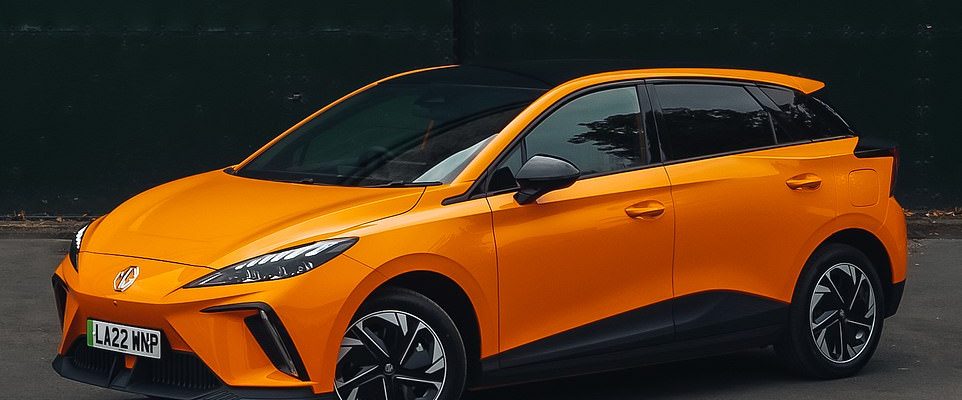Would you buy a Chinese electric car?
No matter your answer, the fact of the matter is that brands from China are starting to flood the UK market, offering a number of electric vehicles that can match the performance and range of legacy European and Japanese makers for a fraction of the price.
But are they any good? Here, we take a look at which five models already on sale, or coming soon, are worth keeping an eye on. And one of the cars in the list may catch you by surprise…
FIVE CHINESE CARS TO CONSIDER
MG4 EV
The MG4 EV is the nation’s least expensive electric five-door family hatchback – and only the Tesla Model Y outsold it in the UK last year
Built in: Ningde, Fujian
On sale: Now (available to order since September 2022)
The MG logo might look familiar, but the brand is very different to the British marque popularised by cars like the MGB, Midget and Metro between the 1960s and 1980s.
That’s because MG Cars was purchased by the Nanjing Automobile Group, following the collapse of the MG Rover Group in 2005, and then became part of the enormous Shanghai Automotive Industry Corporation (SAIC Motor) two years later.
After a few disappointing combustion-engine entries to the market in the early 2010s – notably the lacklustre MG6 saloon – MG’s Chinese parent company has more recently spearheaded a massive electric vehicle (EV) assault.
This has spawned a number of impressive – and cheap – family-size electric cars, including the MG5 EV and MG ZS EV.
But the most accomplished of all is the MG4 EV, launched in 2022.
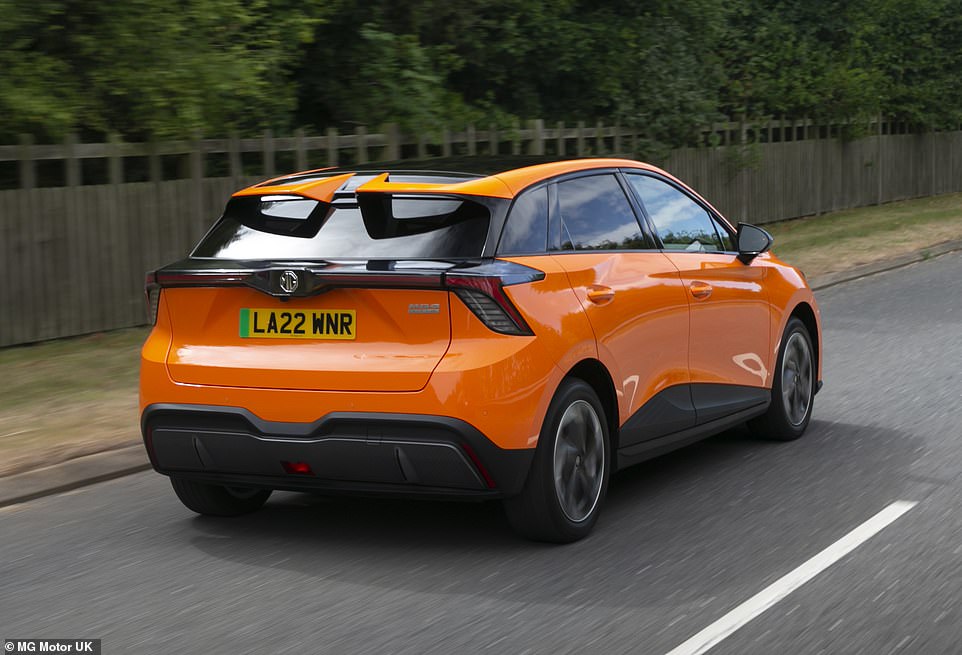
MG Motor has been on an EV assault in recent years. The MG4 EV, which came to the UK in 2022, is the standout model to date
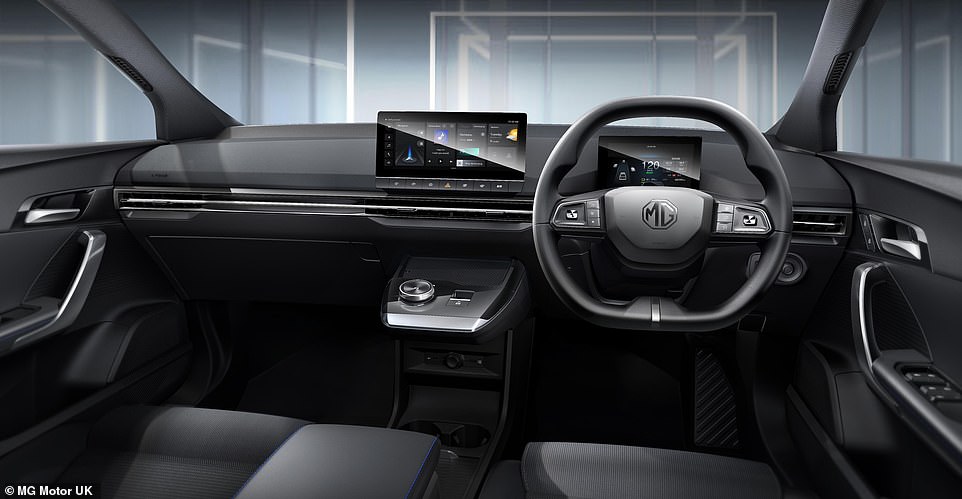
While the interior is pretty basic, it’s inoffensive. We particularly like the drive selector control dial mounted on a platform in the centre console to ensure it’s in easy reach
With a starting price just under £27,000, it’s Britain’s most affordable medium-sized electric family hatchback. And it’s mightily impressive at its price point.
While the cheapest ‘SE’ version (with a 51kW battery) offers just 218 miles of range, four different trim levels with varying full-charge ranges have given customers the choice to make the best compromise between price and driving distance.
The SE Long Range with a larger 64kW battery increases range to 281 miles for just under £30,000, while the Trophy Long Range for £32,500 offers a bit more performance for £32,500, though range is limited to 270 miles.
The longest-distance version is the MG4 EV Trophy Extended Range with a 77kW battery providing 323 miles between charges. While it’s the most expensive – priced at £36,500 – it still beats many of its similarly-priced EV rivals.
Its affordability has seen it shoot up to second in the EV sales charts in Britain.
In 2023, some 21,715 were registered, with the MG4 transforming the trajectory of MG, firmly planting it as a leader in the new EV era.
By the end of last year, more than 62,000 MG4s had been sold in Europe and in 2023 it was even crowned UK Car of The Year 2023.
BYD Dolphin

BYD is the biggest EV maker in the world – it sold more battery cars than Tesla in the last three months of 2023. Of the three models currently sold in the UK, the Dolphin (pictured) is cheapest
Built in: Shenzhen, Guangdong and Changsha, Hunan
On sale: Now (available to order since September 2023)
Made available to UK customers less than a year ago, the Dolphin is one the sea-life themed EVs from massive Chinese car maker, BYD (which stands for Build Your Dreams).
How big is this company? Well, in the EV sphere, bigger than Tesla.
In the final three months of 2023, Elon Musk’s American car brand sold 484,500 vehicles globally. In the same period, BYD shipped 526,000.
Like Tesla, the Chinese conglomerate makes its own batteries, which partly helps it to keep costs low.
The Dolphin is the smallest – and cheapest – model is offers to UK customers.
The five-seat family hatchback is a rival to Volkswagen’s ID.3. But while the German’s electric take on the Golf costs from £35,700, the Dolphin is set to be £10,000 cheaper.
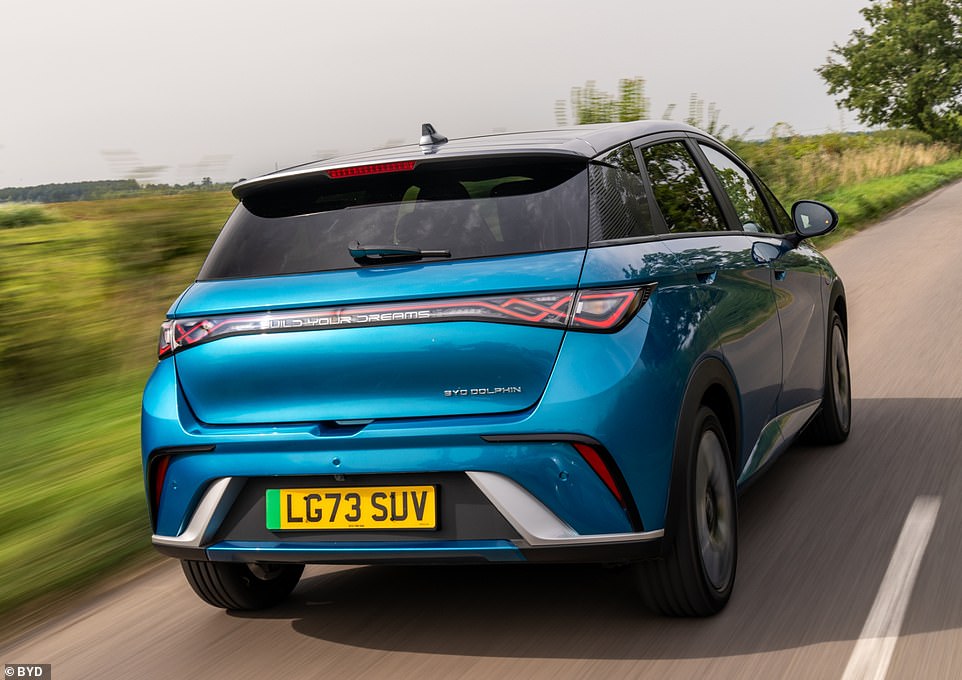
Made available to UK customers less than a year ago, the Dolphin is one the sea-life themed EVs from massive Chinese car maker, BYD
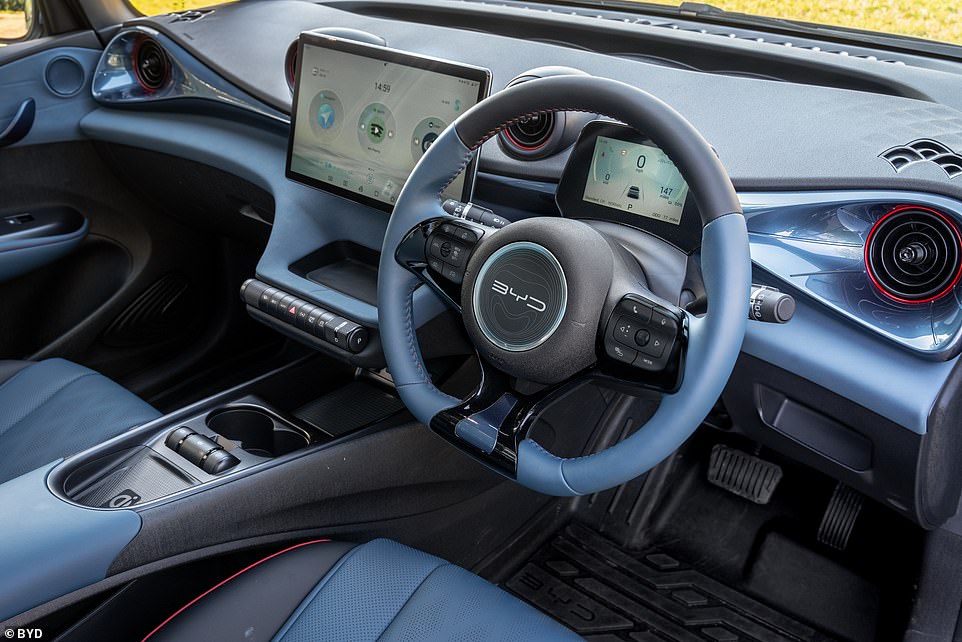
The cabin can be described as ‘interesting’, though this split blue-black finish won’t be to all tastes
There are currently two variants on sale in the UK: Comfort, starting from £30,195 and Design, priced from £31,695.
Both are fitted with a 60.4kWh battery and 150kW (204hp) electric motor that combine enough range (265 miles) to get from London to Middlesbrough without stopping.
And they’re far from shabby.
The Design model, for instance, has a glass roof, rear privacy glass, and wireless smartphone charging.
And cheaper versions with smaller batteries will arrive this year.
The entry-level Active will start from just over £25,000. Its 44.9kWh battery with a 70kW (95hp) electric motor provide an estimated range of 211 miles.
The Boost spec – priced around £26,500 – uses the same battery but a more powerful 130kW (176hp) motor and 17-inch wheels. The increased performance and bigger wheels put a strain on battery range, though it still should be good for 192 miles.
Ora 07

Ora is the first brand from Chinese mega firm Great Wall Motor (GWM) to launch in the UK. We already have the 03 (formerly known as the Funky Cat) supermini but get set to see the new 07 saloon on our roads from this summer
Built in: Taizhou, Zhejiang
On sale: from this summer
Another massive car maker in China is Great Wall Motor (GWM), which has already broken into the UK market with its Ora brand and the debut car, the 03 supermini (formerly called the Funky Cat).
From this summer, Ora is expanding its vehicle line-up to the 07 saloon, which will be sportier and more practical in size – and look to steal sales from European mainstays such as Vauxhall’s Astra Electric and the Peugeot e-308.
Prices have yet to be rubberstamped by GWM, but it is widely expected to start from £35,000 in the UK.
Two battery sizes and four trims are set to be made available to customers in Britain: the 07 Pure and 07 Pro will use a 64kW battery, while the Pro+ and GT will get a bigger 83kW pack.
The longest-travelling on a full charge promises up to 354 miles, which is isn’t far off the range of Tesla’s Model 3 Long Range (390 miles) – which rings in at £50,000.
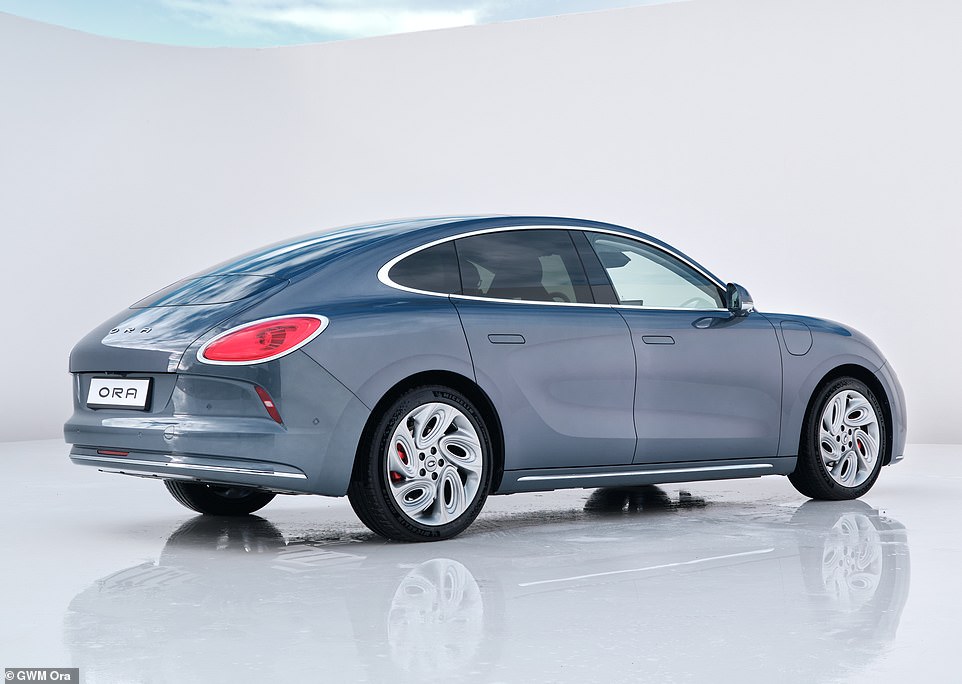
The 07’s design won’t be to all tastes. This rear three-quarter image makes it look like a deformed Bentley Continental GT

Where the Ora could win over UK customers is the 07’s interior. It looks plush and far more luxurious than the £35,000 price tag suggests
It will be relatively rapid, too. The GT spec with all-wheel-drive is said to pack 402bhp and accelerate from zero to 62mph in 4.5 seconds – that’s dipping into internal combustion engine sports car territory.
Where it will look to steal a march on European legacy rivals is the interior – which, in photos alone, looks to be punching well above its price. We really like the Bugatti Chiron-like centre console spine housing the temperature controls.
Domestically (where it is called the Lightning Cat), it helped to ignite Ora’s sales after disappointing take-up of the smaller Funky Cat. GWM will be hoping for a similar reaction in the UK, where Ora sold just 911 03s/Funky Cats in 2023.
Omoda 5
Price: approx £30,000 (£24k for 1.6-litre petrol)
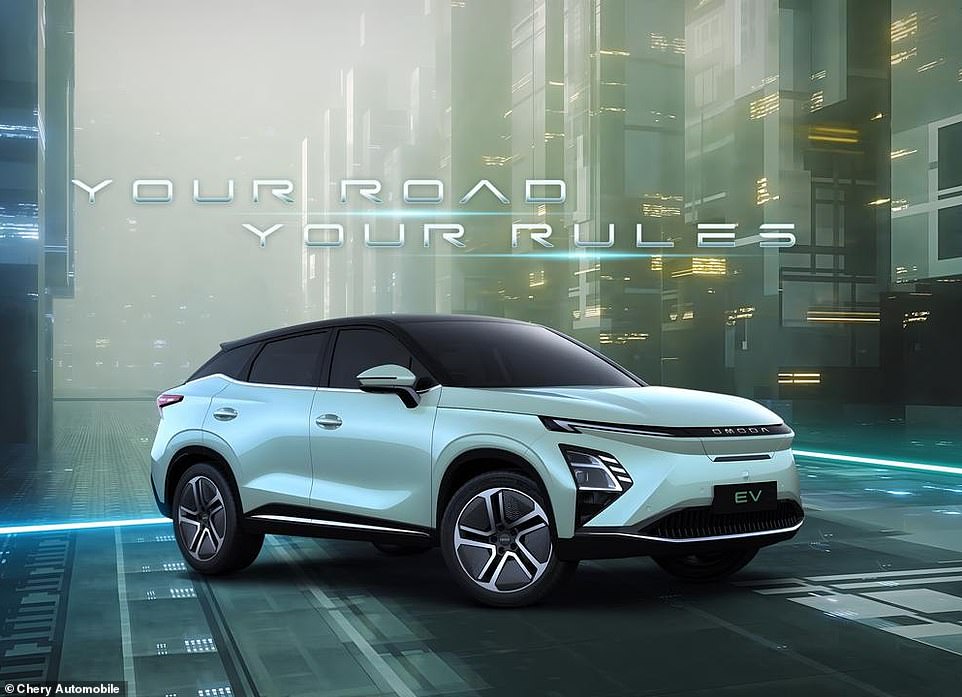
Omoda is a subsidiary brand of China’s biggest car maker, Chery. It will enter the UK market in 2024 with the Omoda 5 SUV, which is sold first with petrol engines and an EV (pictured) will follow later in the year
Built in: Wuhu, Anhui
On sale: Petrol on sale, EV to follow later this year
One Chinese car maker set to break into the UK market that’s doing things a little differently is Omoda, which is a subsidiary of China’s largest car firm, Chery Automobile Company, which is based in Wuhu.
It has just started to sell Omoda 5 SUVs to British customers… but not electric versions.
The launch models are 1.6-litre petrols with seven-speed dual-clutch automatic gearboxes, starting from an extremely reasonable £24,000. And that gets you a generously-equipped family car – one with Apple CarPlay and Android Auto and wireless charging for two mobile phones as standard. Premium trim levels (for under £30k) get 360-degree exterior 3D parking cameras and a raft of advanced safety equipment.
Cars will be sold across a blooming new retail network, with bosses aiming to open 50 showrooms in the UK.
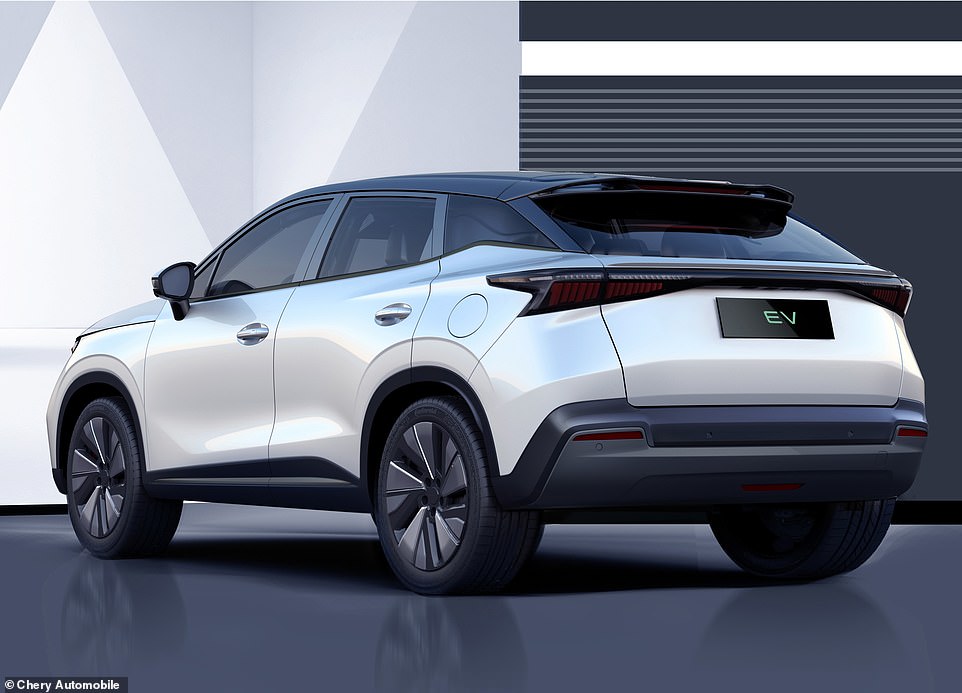
The launch models are 1.6-litre petrols with seven-speed dual-clutch automatic gearboxes, starting from an extremely reasonable £24,000. The EV is expected to ring in at around £30k
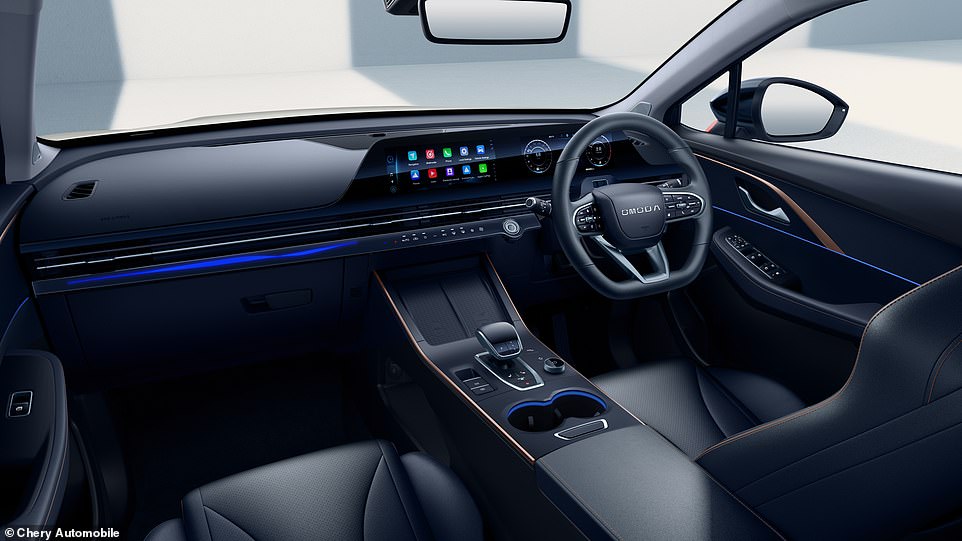
Omoda says the 5 will be a generously-equipped family car – one with Apple CarPlay and Android Auto and wireless charging for two mobile phones as standard
An electric version will follow shortly but has yet to give an exact release date or pricing – though expect it to be around the £30,000 mark.
What we do know is it will have a range in the region of 280 miles, thanks to an electrified combination of a 61kWh battery and 204hp motor that drives the front wheels. The battery can also be charged from 0 to 80 per cent in just 30 minutes, granted to can find a compatible 110kW rapid charger.
Mini Cooper E.. the surprise car

While the electric version of the new fourth-generation Mini Cooper isn’t necessarily a Chinese car, it will be produced in the country at Great Wall Motor’s Zhangjiang factory
Built in: Zhangjiagang, Jiangsu
On sale: Available to order now
‘Whoa, whoa, whoa, the Mini isn’t a Chinese car,’ we hear you say.
Well, technically, the new electric Cooper is.
That’s because the battery-powered version of BMW’s fourth-generation Mini is being produced in partnership with Great Wall Motor. And it is GWM’s factory in Zhangjigang, Jiangsu, where it will be built.
But not forever.

The entry Cooper E (pictured) will be powered by a 40.7kWh battery and 184hp electric motor that allows it to accelerate from 0-to-62mph in 7.3 seconds up to a top speed of 99mph and with a range of 190 miles
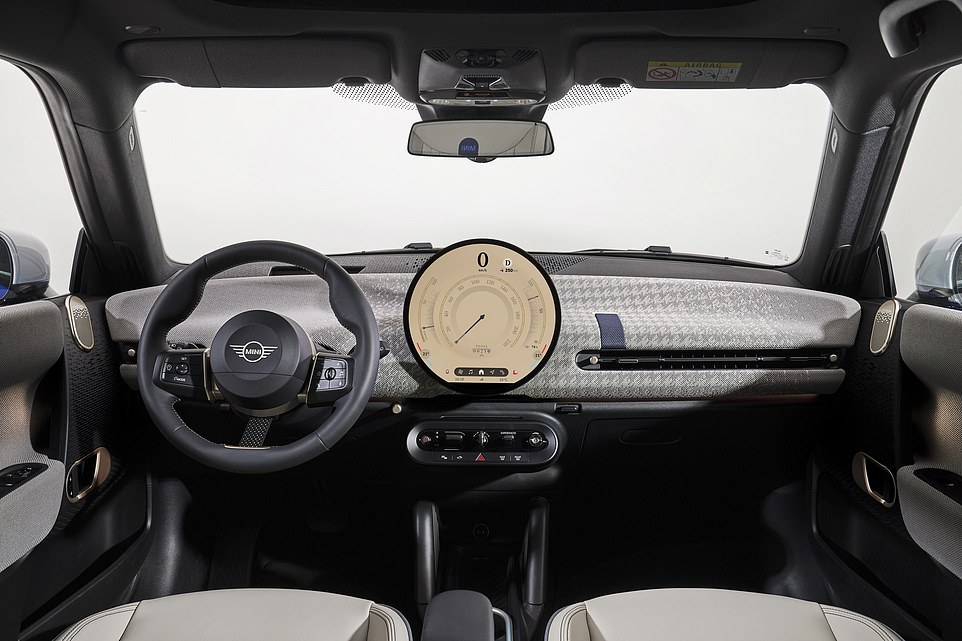
Inside, it’s a modern twist on the classic Mini cabin. Replicating the original’s centrally-mounted speedometer is the world’s largest round OLED touchscreen display to feature in a car
BMW confirmed last September that it will make its next-generation electric Minis in Oxford around the end of the decade after securing a government funding package.
The German-owned brand will pump £600million investment to transform Mini’s Cowley factory into a state-of-the-art EV production site – a move described by both BMW and the Government as ‘a vote of confidence in Britain’ and one that will safeguard a national automotive icon.
It will secure 4,000 UK jobs and see the Oxford site become an electric-only production line from 2030.
As for the Mini Cooper E and SE made in China until then, prices are due to start from around £30,000. Order books are open with first deliveries due later in 2024.
The entry Cooper E is powered by a 40.7kWh battery and 184hp electric motor that allows it to accelerate from 0-to-62mph in 7.3 seconds up to a top speed of 99mph and with a range of 190 miles.
The more powerful 218hp Cooper SE variant with a 52.2kWh battery cuts the 62mph sprint time to just 5.7 seconds and ups the top speed to 106mph while extending the range to around 250 miles.
Inside, it’s a modern twist on the classic Mini cabin. For instance, replicating the original’s centrally-mounted speedometer is the world’s largest round OLED touchscreen display to feature in a car.

Are more Britons considering buying a cheap Chinese electric car? Carwow’s latest study said appetite is growing – though seven in ten UK drivers still have major reservations
Are Britons considering buying Chinese EVs?
A survey conducted by car buying and selling website Carwow – exclusively shared with This is Money – shows that almost three in ten (29 per cent) UK drivers are now considering a Chinese vehicle for their next car.
This trend is on a steady upward trajectory, the vehicle marketplace said, referencing the same survey in October that found 27 per cent would consider a car from China next, and up from 24 per cent when drivers were polled last June.
The latest survey found that 27 per cent of the 1,007 motorists quizzed associate Chinese cars with value for money, while one in five believe they are more competitively prices than mainstream brands we’re more accustom to.
Around one in eight (12 per cent) believe Chinese cars offer ‘more choice’ when it comes to EV models and 8 per cent think they have longer ranges.
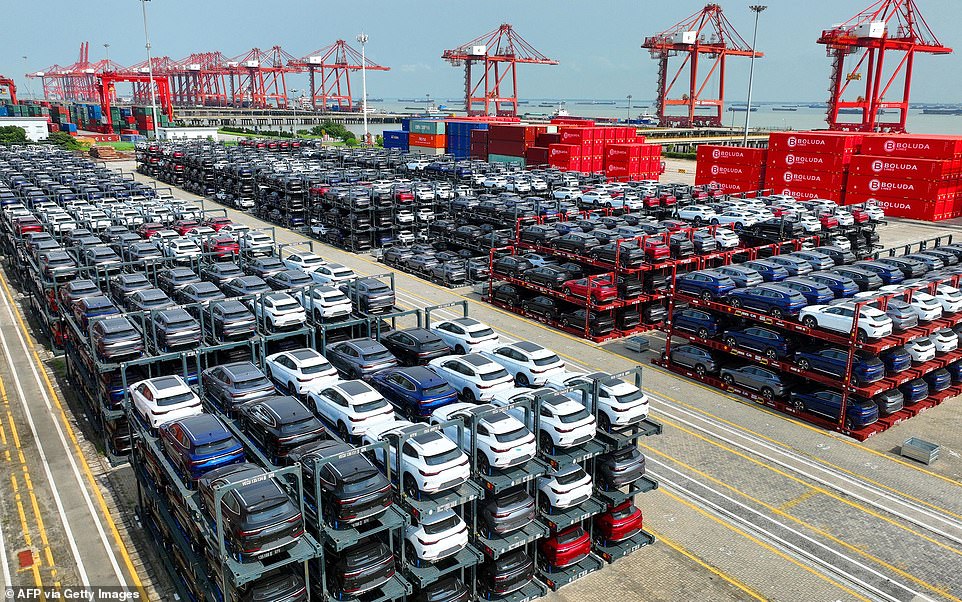
BYD electric cars waiting to be loaded onto container ships at the terminal of Taicang Port at Suzhou Port, in China’s eastern Jiangsu Province
While Carwow’s study suggests an increase in appetite, the vast majority of motorists surveyed still have major reservations about buying Chinese cars.
The biggest of these is build quality (36 per cent), though a quarter said they have concerns about data and privacy security amidst recent reports that Beijing could remotely control Chinese cars driven on Britain’s roads.
Other perceived negatives of Chinese brands include apprehension about after sales support and servicing (25 per cent) and more than a third (37 per cent) noted political reasons for not wanting a car made in the Far East country.
Philipp Sayler Von Amende, chief commercial officer at Carwow, says that many of the perceived negatives of Chinese brands are ‘wrong’, and that their future is bright – even if sentiment needs to shift.
‘The fact that almost one in three drivers would now consider a Chinese car shows that some of the negatives are shifting, but our polling also shows that there is still a way to go,’ he said.
‘Negative perceptions about build quality and safety still remain, despite the fact that build quality on Chinese cars is now very high, and Chinese-built vehicles are achieving some of the highest safety ratings on the market.
‘Brand awareness is also still low, so Chinese car manufacturers that want to win over UK motorists need to address that challenge too.
‘One area where Chinese brands are making huge inroads is the EV market, as they are successfully addressing the key concerns – namely range anxiety and price – that are preventing UK motorists from making the switch to electric.’
‘We need Chinese cars,’ says IEA
A new report published by the International Energy Agency (IEA) has said that the UK and other countries cannot hit its Net Zero targets without the help of Chinese car manufacturers, amidst calls from the EU to introduce tariffs on these brands.
Last year, 57 per cent of all new global EV registrations were Chinese vehicles, and the European Commission has now launched a probe into whether Chinese makers are gaining an unfair ‘competitive edge’ thanks to their government-subsidised cheaper prices.

European Commission president Ursula von der Leyen (pictured) in September announced a probe into the Chinese car market amid growing concerns about import numbers
Commenting on the IEA’s report, Thom Groot, CEO of The Electric Car Scheme, said: ‘If we are serious about hitting our 100 per cent goal by 2035 and overall Net Zero ambitions, we should be embracing this [Chinese] technology input, not shying away from it.
‘While there have been discussions around national security and cyber attacks involving Chinese EVs, tariffs, which punish less well-off consumers most, are patently not the answer.
‘Our research shows that for 68 per cent of people cost is the biggest barrier to getting an electric car, we should be trying to reduce the size of this barrier not maintain it.
‘If there are legitimate concerns with cyber security, the answer is not to make the Chinese EVs more expensive but to find an effective resolution using technology and strict cyber security regulations, if there are none, we should be welcoming more affordable EVs.’
Some links in this article may be affiliate links. If you click on them we may earn a small commission. That helps us fund This Is Money, and keep it free to use. We do not write articles to promote products. We do not allow any commercial relationship to affect our editorial independence.

